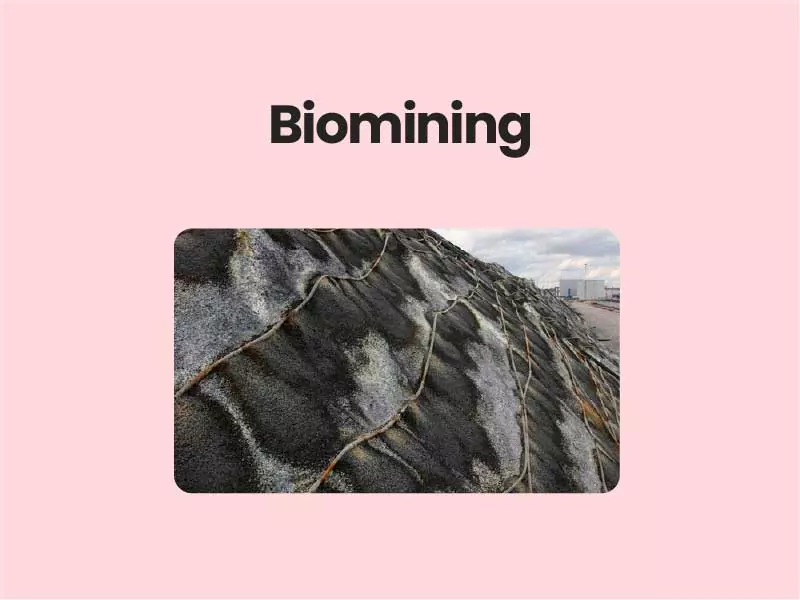Biomining using microbes is an emerging biotechnology that applies microorganisms in the excavation of minerals from their ores underground. The method is eco-friendly and depends on the natural interaction between minerals and microorganisms that are often used to extract valuable minerals from natural mineral stones.
There are many microorganisms except for bacteria and archaea capable of undertaking naturally. This method has been widely used for mining, especially in areas where minerals are found in small quantities, that is, scattered in a small percentage in the soil or the remains of ore concentration.
Minerals that can be mined by microorganisms are gold, copper, silver, cobalt, uranium, zinc and nickel. The microorganisms that are mostly used for the mining are Thiobacillus thioxidans, Thiobacillus ferroxidans, Pseudomonas fluorescens, Pseudomonas putida, Achromobacter, Bacillus licheniformis, Thiobacillus thermophilica and Sulfobus acidocaldarius.
The microorganisms are often found in our environment and are collected and then cultured (multiplied) in the laboratory to meet the needs of mining demands. The multiplication of bacteria and archaea in mining is made easy due to the reproductive capacity they possess and their significance in ensuring environment conservation in the process of mining.
Read Related: Microbes: Earth’s Unseen Architects and Climate Change Warriors
In Africa, it has already started to be used in countries like Uganda and South Africa and it is time for Tanzania to adopt biotechnology as the method of promoting environmental sustainability.
Impact of Mining Activities on The Ecosystem
Human activities have been increasing daily due to the increasing human needs and this situation in one way or another leads to environmental degradation. Biodiversity is endangered as species undergo complete extinction on the land or sometimes being threatened with extinction.
Massive environmental degradation including cutting down trees, excavating the land and massive utilization of water resources all result from uncontrolled mining practices. In developing countries such as Tanzania where mining is done rudimentary, especially by small-scale and artisanal miners the ground is excavated and then abandoned creating large holes that are dangerous to both the ecosystem and human health.
How Microorganisms Work
The use of micro-organisms in mining is a technology that stands as a solution and alternative to the aggressive method of mining that is currently used with a high impact on the environment. Microorganisms in mining ensure environmental conservation and safety in the mining area and beyond. There are two methods which are used for mining by using microorganisms as follows:
- The direct method is often used by organisms capable of oxidizing iron with sulfur directly by electrons from the reduction of minerals This method is often used by bacteria such as Thiobacillus thioxidans which act as oxidizing agents where microorganisms are introduced to the mineral ore. Then, enzymes in the bacteria separate the minerals from the ore.
- The indirect method does not allow physical contact between organisms with mineral rocks. During the process, they produce chemical particles that are used to process mineral ore. These chemicals come into contact with ore resulting in leachate with a mixture of minerals.
Ways of Mineral Excavation by Using Micro-organisms
Biomining by microbes can be done practically; Firstly, by the creation of heaps of mineral soil where a mixture of microorganisms is sprinkled in the heap and later collects a mixture of soil with minerals and liquid with microbes that have already come into contact with the minerals, the method is widely used harvesting in minerals from residues in heaps from mining areas.
Also, read: World Environment Day 2024: A Call to Combat Desertification and Drought
Secondly, formulating slopes where the soil is made very small by compaction or compression and then collected in a slope system. The liquid with insects is sprinkled in the soil and then after a while, the mixture of liquid with insects and soil gathers at the bottom.
Thirdly, mineral ore is positioned underground as its normal location where liquids containing microorganisms, often bacteria-type Thiobacillus thioxidans and Thiobacillus ferroxidans are injected to reach the location of the minerals. After, the liquid leaves microbes reacting with mineral ores. In the end, a mixture of microorganisms with minerals is released to the ground for extraction to obtain pure minerals.
The development of technology in today’s world is simplifying and maintaining safety in human life and its environment, the use of microbial biotechnology in mining is a solution to the challenge of environmental degradation.
Mining using natural methods produces toxins from sulfur dioxide which causes health problems for miners but using microbes eliminates the risk to the miners. Also, microbes help to treat harmful chemicals caused by sulfates thus avoiding eutrophication in water bodies that could be caused by mining.
Finally, microbes clean up the acid in areas as a safe method of rehabilitation after mining closure. Thus, Tanzania should draft strategies to start using biotechnology for environmental conservation, human safety and productive mining that take into consideration environmental sustainability for the benefit of future generations.

